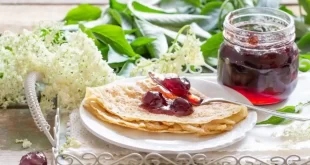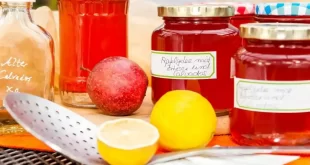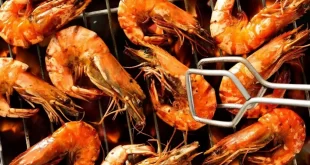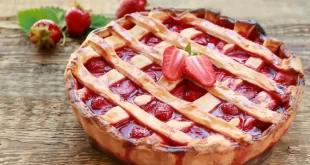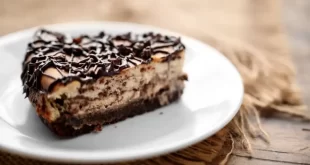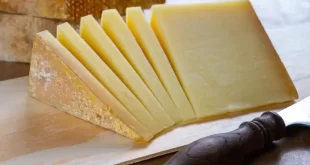I used to wait tables in a vegetarian restaurant many years ago, and one of the items on the menu was Cashew Chili. I would say about one-third of the customers would look at the menu, then look up at me, and ask – “Are there cashews in the Cashew Chili?”

DoramasQueen was hard to respond to that. Although the answer “Yes” seemed pretty obvious (at least to me), it was hard to say “Yes, the Cashew Chili has cashews in it” without sounding like a wise-ass. Thinking about it now, I probably could have come back with a more exciting retort, and I guess I should think of another one for this chili recipe because it is made with beans and will likely raise some hackles.
Therefore, I would like to recognize that real Texas Chili does not have beans officially. But when you have beautiful Rancho Gordo beans in your kitchen, and you don’t live anywhere near Texas, I took it upon myself to cash in one of my “free pass” cards you get when you live overseas and make a bean-based chili.
I’ve wanted to make chili for ages, and when I was sent a copy of The Rancho Gordo Heirloom Bean Grower’s Guide, its arrival prompted me to open one of my precious packages of Rancho Gordo beans and hit my local butcher shop.
One of the few things I usually bring back to France are these beans, and the bean packets fit neatly in and around all the unfilled spaces in my suitcase. They’re perfect because I don’t have to worry about squishing them. And their special one-pound packaging lets me add as many as I need to to get me right to my luggage weight limit without going over.

My French guests have never seen beans like these and are always amazed by their swirling, variegated designs. Names like Good Mother Stallard and Yellow Eye don’t precisely translate, but I’ve never had one complaint in my years of cooking them. Where you are, you can use whatever chilies you like. Mine was a gift from a guest from Mexico, and I’m not sure what kind they are, but most are labeled. If it doubts, ask. You can use either fresh or dried chilies for this recipe.
Since I veered from tradition already with the beans, I also added some chocolate, giving the additional chili depth of flavor. It doesn’t take much like chocolate, but it adds a smooth underlying richness that goes well with the spicy bean and beef chili.
Chili with Chocolate
There are lots of ways to soak and cook dried beans. Some use a pressure cooker, and others use the soak and simmer method, as I do. If you wish to use canned beans, use 8 cups (1kg) of red or pinto beans with their liquid in place of the cooked dried beans. I start my chili the day before by salting the meat and soaking the beans, although you can omit the first two steps and go right into the recipe. In France, butcher shops sell beef, especially for long stewing, called Morceaux de bourguignon. (Or paler on or gîte.) For those who can’t get unsweetened chocolate, use an extra ounce (30g) of bittersweet or semisweet chocolate and maybe skip the brown sugar.
As mentioned, use whatever chilies (fresh or dried) are available to use.) I did find out from my friend the kind she gave me were pasilla and guajillo. And feel free to dial up the spices if you’d like. I kept it more moderate since I like the flavor of the beans to shine through. But you can undoubtedly season to taste. Most dried chilies will soften once they are rehydrated then simmered in the chili. If you think they won’t, you can puree them and add them to the pot.
Ingredients
- 1 pound (450g) dried red or variegated heirloom beans
- One bay leaf
- 2 pounds (1kg) of beef stewing meat, such as boneless short ribs or chuck roast, cut into 1-inch (3 cm) cubes
- Three teaspoons salt (total), smoked if available
- 2 to 4 dried chilies, or one fresh Chile, minced
- about two tablespoons of cooking oil
- Two medium onions, peeled and diced
- Four cloves of garlic, peeled and minced
- 2-3 teaspoons red Chile powder
- One teaspoon of ancho Chile powder (if available, otherwise use an additional teaspoon of red Chile powder)
- Two teaspoons of dried oregano
- Two teaspoons of ground cumin
- One teaspoon paprika
- 2 cups (50cl) beer
- Two cans (15oz, 200g each) of crushed or diced tomatoes
- One tablespoon of brown sugar
- 2 ounces (55g) unsweetened chocolate (or 3 ounces, 85g, bittersweet chocolate)
- Three tablespoons of cider vinegar or lime juice

Steps
- Rinse the beans and sort them to remove any debris. Put in a bowl, cover cold water, and let soak overnight.
- Put the beef cubes in a freezer bag with 1 1/2 teaspoon of salt, massage gently, and refrigerate overnight.
- The next day drains, the beans cover with several inches (centimeters) of water. Add the bay leaf and bring it to a full boil for ten minutes. Lower the heat to a gentle simmer and cook until tender, one to three hours, adding more water if the water boils away. Once done, remove the bay leaf.
- Heat the oil in a large casserole or Dutch oven (at least 6 quarts, 6l). Working in batches, so you don’t crowd the pan, brown the pieces of beef, resisting the urge to turn them until they are lovely and dark on each side. The browning adds a good deal of flavor. As the meat pieces brown, remove the details to a separate plate and brown the remaining pieces. If necessary, add a bit more oil to the pan as you go.
- If using dried chilies, snip them into a small bowl in very tiny pieces with scissors and pour just enough boiling water over them to cover. If using fresh chilies, remove the stem and chop them finely. Set them aside. (You can either discard the seeds, which are hot or use them.)
- Once all the meat is browned, fry the onions in the pot until they are wilted, about 5 minutes. Add the garlic and fresh chilies (if used), as well as the remaining 1 1/2 teaspoon salt, Chile powders, oregano, cumin, and paprika, and cook for another minute, constantly stirring to release the flavors of the spices.
Add the beans to the pot along with their liquid, as well as the dried chilies (drained of their liquid), beer, tomatoes (with their juices), brown sugar, and chocolate. - Simmer the chili at the absolute lowest temperature possible (I use a flame-tamer) for at least 1 hour or until the meat is tender. If necessary to cook much longer, you may need to add additional water if the chili becomes too thick. When done, stir in the vinegar or lime juice. Taste and adjust any seasonings, such as the Chile powder and salt.

Notes
Serving: There are plenty of ways to serve Chile. Some like it over rice, others prefer it plain. You can offer bowls of grated cheddar cheese, sour cream, sliced green onions, and chopped cilantro so guests can customize their bowls. Cornbread is a great accompaniment, too. There are some recipes in the links below.
Storage: Chili can be refrigerated for up to three days or frozen for at least two months. It will thicken considerably on subsequent days, so you may wish to thin it with water or beer when reheating it.
Notes on dried beans: It’s best to use the freshest dried beans you can find, which sounds a bit like an oxymoron. But the dried beans you buy might have been sitting in the store for several years before they arrive in your kitchen. So try to get them from a place that sells them relatively quickly. Steve Sando of Rancho Gordo recommends using beans that have been dried within one year, if possible. Any dried beans over two years old may not soften.

If you live somewhere where the water is mineral-rich (hard) like it is in Paris, the locals add a pinch of baking soda (sodium bicarbonate) to the cooking water, although when I told Steve that we did this in France, he shook his head vigorously “no.” So next time he comes to France, I’m inviting him over to cook some beans for me ).
In his book, he discussed various methods of cooking dried beans, from using clay pots to pressure cookers, which he’s not a fan of because the bean liquids don’t get reduced. I haven’t tried one, so I can’t comment, but one great tip he offers is to use a large enough pan so that the beans and their liquid have plenty of room to circulate hot air above them. Choose a pot large enough so that half the pot is empty when cooking the beans.

 DoramasQueen Encuentra todos los doramas sub español online
DoramasQueen Encuentra todos los doramas sub español online



